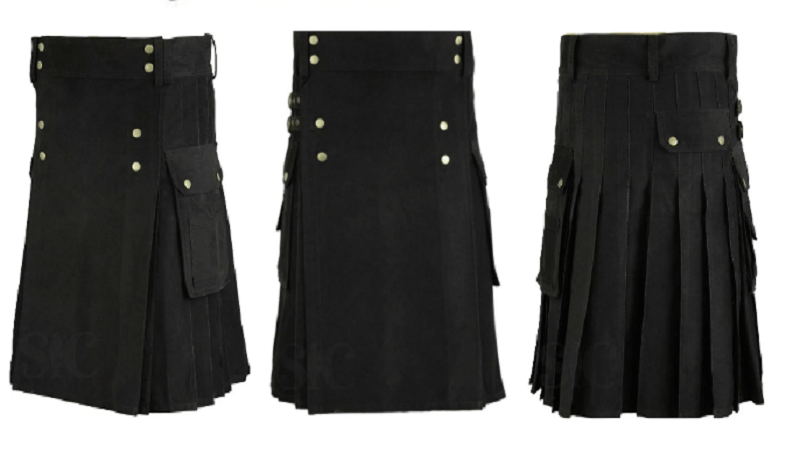The kilt’s extensive history, which dates back to the 16th century, means that wearing one is associated with expectations for behavior. The current kilt is about a century old, and its style hasn’t changed much in that period. If you are unfamiliar with this customary Highland attire, we have outlined the key points to consider before purchasing men’s kilts. After that, picking out a kilt ought to be easy. This is our easy-to-follow purchase guide for men’s kilts.
What is Kilt?
A kilt is a knee-length skirt-like item of clothing made of worsted wool woven in a twill weave, including strong pleats at the back and sides, and traditionally patterned in tartan. Originally known as the great kilt, a full-length garment whose upper half could be worn as a cloak, it dates back to the 16th century and is associated with men’s Highland clothing in Scotland. The 18th century saw the emergence of the little kilt, or contemporary kilt, which is just the smaller version of the large kilt. It has been linked to Scotland’s broader culture and, more widely, to Gaelic or Celtic ancestry since the 19th century.
WHAT ARE THE PARTS THAT MAKE UP A MEN’S KILT?
Apron
This is the front, overlapped, unpleated portion of the kilt.
Pleat
Fabric which is sewn over itself in a fold. This is what most kilts’ backs are made of.
The small kilt sometimes called a walking kilt or a Philbeg, is a type of clothing that covers the lower body from the waist to the knees. The most well-known men’s kilt is this one.
Excellent kilt
A men’s kilt that is full length and may be wrapped around the upper body
Kilt Straps
These fasten the kilt by buckling at the side.
Kilt Pin
An ornamental piece worn on the apron’s front layer that does not keep the flap closed
Sporran
Traditionally worn at the front of men’s kilts, a skin purse with the hair or fur left on. There are also more contemporary leather handbags.
WHICH TARTAN IS APPROPRIATE FOR MAKING YOUR MEN’S KILT?
A sett is the term for the tartan design worn on a kilt. This has to do with the weight, color scheme, amount of threads, and weaving pattern. The majority of setts are registered to a clan, thus there are social customs around who can wear them even though they are not legally restricted by trademark. Try using a search service like House Of Tartan to trace your ancestry if you do not have a known clan tartan.
To find out which clan you belong to and, consequently, what tartan sett to wear with your men’s kilt, just enter your surname. If you are not directly related to any clan, you can try searching for your mother’s and grandmother’s maiden names to see if you have any links. Some universal tartans are Black Watch, Caledonian, Hunting Stewart, and Jacobite tartans.
MEN’S FITTED MADE KILTS
Like a nice black tie or interview suit, a proper kilts for men is a tailored item. Cheap or off-the-rack kilts are not fashionable and do not allow for proper size. This can result in the kilt falling short of your knee, which is a highly inelegant look. To guarantee the ideal fit, a large number of our men’s kilts are handmade. You will wear your kilt frequently, to parties and gatherings, and frequently in front of those who are familiar with men’s kilts. A poor-quality kilt will undoubtedly be noticed right away and looked down upon.
Your hips, waist, and potentially your rise—the measurement from your waist to your groin—are the areas where you’ll need to know your measures. This will guarantee that you wear your custom-made men’s kilt traditionally while maintaining style and honoring tradition.
ACCESSORIES FOR YOUR TRADITIONAL KILT
When dressing for a formal function, do not forget the necessary accessories. Men’s kilts go well with a waistcoat, shirt, tie, jacket, hose, or knee socks. You should also wear a sporran, a kilt pin, and Ghillie brogues—a particular style of shoe—to finish the ensemble. To give it a genuine appearance, you might also add:
A sgian dubh is a small ceremonial knife worn with the hose partially hidden, so only the hilt is visible. Sock flashes – Small pieces of tartan connected to the hose, are also an option and should be worn to match your kilt tartan. These are the standards for formal kilt wear; there are no customs or regulations for casual kilts, such as men’s leather or utility kilts, which can be worn with any regular daytime attire. Check out our wide selection of men’s kilts, tartans, materials, and cuts before making your decision.
Conclusion
While men wear kilts mostly for formal events, such as Highland games and other sporting events, they have also been known to wear them casually, going back to when they were common men’s clothes. Kilts are now available in many different materials for casual use. To do away with the necessity for a sporran, pockets, and other substitute fastenings can be included. For some sports, women are now required to wear kilts.
